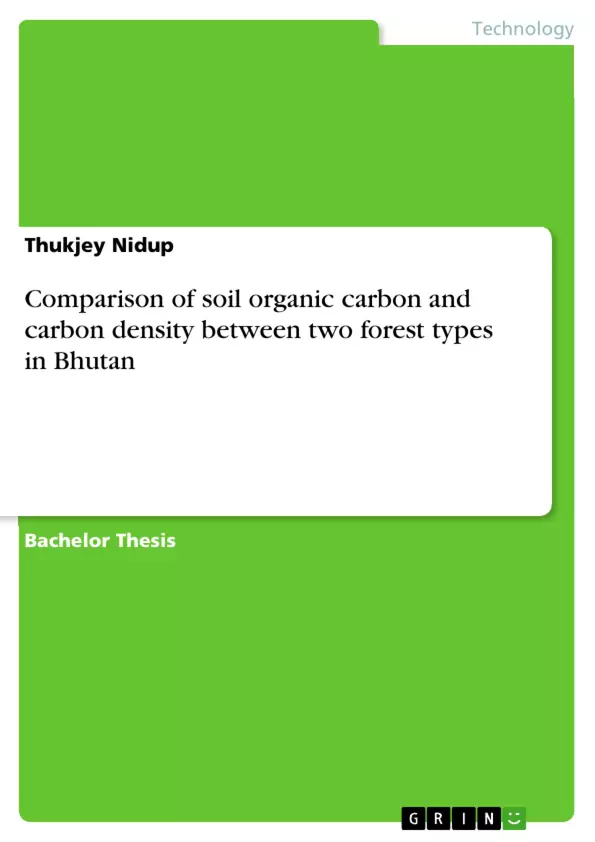This study investigated the total Soil Organic Carbon (SOC) density and its distribution under two different forest types considering the change in carbon with elevation in two different depths of the soil in Nahi Gewog, Bhutan. This work will serve as baseline data for further research on soil carbon density.
The soil, being one of the carbon pools, hosts the largest terrestrial carbon and plays a crucial role in the global carbon balance by regulating the exchange of greenhouse gases with the atmosphere. The Earth is facing increased pressure from emission of Greenhouse gases which leads to change in natural climate system from good to worse. Bhutan is considered as carbon neutral country and the country has large masses of forest soil which have huge potential for carbon absorption than to release into atmosphere which would otherwise attributed to Global warming.
Inhaltsverzeichnis (Table of Contents)
- Introduction
- Background
- Problem statement
- Research objectives
- Literature Review
- Soil Carbon sequestration
- Soil Carbon stocks in different slope and aspect
- Soil organic carbon stock along the altitudinal gradient
- Vertical variation of carbon stock
- Influence of succession of soil organic carbon storage
- Soil Bulk density
- Method for measuring Carbon
- Loss on Ignition method
- Walkley-Black method
- Non-Destructive Techniques
- Materials and Methods
- Study area
- Soil sampling procedure
- Determination of soil organic matter and organic carbon
- Determination of soil bulk density
- Calculation of Carbon Density
- Statistical data analysis
- Results and Discussion
- Checking Normality of data
- Soil bulk density of different forest types
- Soil organic carbon concentration in two types of forest
- Organic carbon density at different aspect
- Organic carbon at different slope
- Soil organic carbon and carbon density along altitudinal gradient
- Variation of soil organic carbon density with depth
- Conclusion
- References
Zielsetzung und Themenschwerpunkte (Objectives and Key Themes)
This study investigates the relationship between soil organic carbon (SOC) content and carbon density variations along altitudinal gradients, slope aspects, and different forest types in Nahi Gewog, Bhutan. The study aims to understand how SOC is influenced by elevation, slope aspect, and forest type, and how these factors contribute to the overall carbon density of the soil.
- The role of soil as a carbon pool in the global carbon balance and its importance in mitigating climate change.
- The influence of elevation, slope aspect, and forest type on soil organic carbon density and distribution.
- The relationship between soil bulk density and soil organic carbon content.
- The impact of soil depth on soil organic carbon density.
- The potential for soil carbon sequestration in Bhutan and the importance of understanding carbon dynamics in the Himalayan region.
Zusammenfassung der Kapitel (Chapter Summaries)
The introduction provides a background on the role of soil carbon in the global carbon cycle and the importance of studying soil carbon sequestration, particularly in the context of Bhutan's commitment to carbon neutrality. It also outlines the research objectives and highlights the need for a better understanding of carbon dynamics in the Himalayan region.
The literature review delves into existing knowledge on soil carbon sequestration, focusing on factors influencing soil carbon stocks, such as slope aspect, elevation, and forest type. It also discusses various methods for measuring soil carbon.
The materials and methods section describes the study area in Nahi Gewog, Bhutan, the soil sampling procedure, and the methods used to determine soil organic matter, carbon density, and soil bulk density. It also outlines the statistical analyses used to analyze the data.
The results and discussion section presents the findings of the study, analyzing the relationship between soil organic carbon content and carbon density with elevation, slope aspect, and forest type. It examines the distribution of carbon density at different depths and discusses the significance of these findings.
Schlüsselwörter (Keywords)
This study focuses on soil organic carbon, carbon density, elevation, slope aspect, forest type, soil depth, and carbon sequestration. The research investigates the relationship between these factors and their impact on soil carbon dynamics in the Himalayan region, with a particular emphasis on Bhutan's role in carbon neutrality.
- Quote paper
- Thukjey Nidup (Author), 2020, Comparison of soil organic carbon and carbon density between two forest types in Bhutan, Munich, GRIN Verlag, https://www.grin.com/document/520406



